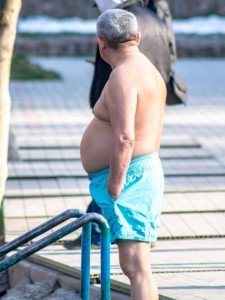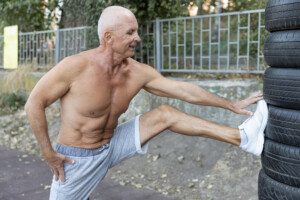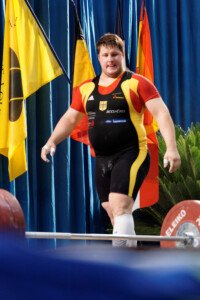
Why is it that as men get older, their gut gets bigger?
Some men look like they’re in their fourth trimester. Some men with big guts have thin legs and arms.
I am a former personal trainer at a large gym and worked with men who had the classic big belly that didn’t match the size of their arms and legs.
This is a common feature in men as they get older.
Often, the belly is out of proportion to the rest of the body.
The vast majority of excess fat in these men is stored in the middle, while there isn’t that much excess fat in the arms or legs.
One myth is that the big belly is caused by excess beer intake.
But if this were really true, why is it that the waistline expansion coincides with getting older?
Do men drink more beer as they get older?
Why don’t more 20-something men who are heavy beer drinkers have a fat belly that’s out of proportion to their legs and arms?
Another myth is that the accumulation of fat in the stomach is an inevitable byproduct of aging.
What’s really going on when a man’s belly gets bigger as he gets older?

Shutterstock/Vladimir Konstantinov
- It’s not the aging process in and of itself.
- Instead, it takes years for muscle mass to wither away enough to cause a big increase in stomach fat.
Have you ever seen a man with ripped-muscled arms and legs…AND a Santa Claus belly?
Have you ever seen a man with a six-pack and an exquisitely muscular chest, back and shoulders—but flabby arms and flabby legs?
The General Rule of Belly Fat Gain from Loss of Muscle
The stomach will begin expanding as muscle mass decreases. The No. 1 cause of muscle mass loss is the absence of weightlifting.
After about age 30, muscle mass disappears at a rate of three to five pounds per decade.
A typical 60-year old man may have 15 pounds LESS muscle than he did at age 30.
If a young man works out hard with weights, he will keep his muscle well into his 60s. He will not have an ever-expanding middle.

Muscle burns more calories than any other tissue. If you start losing muscle, your resting metabolism slows down.
A slowed metabolism means fat gain. There’s less muscle, so there’s now a calorie surplus because the muscle — that’s no longer there — had been eating up those calories.
The extra calories get stored as fat. In men, the first place of fat storage is the gut.
What about Olympic weightlifters with bellies hanging out as they lift super heavy barbells above their head?

Source: Dacoucou/CC
Look at their arms and legs. Are they ripped with muscularity? Or are they just thick and burly?
They are thick and burly. There’s muscle underneath and lots of strength, but you can’t possibly say that their arms and legs look like those of a physique athlete.
Olympic weightlifters are concerned about performance, not body composition or looks.
They make sure they get plenty to eat to subsidize their training and build muscle. Sometimes there’s a caloric surplus.
Remember, they train to lift as heavy as possible, not to look as buff as possible.
Look at the typical older man off the street who has a fat belly.
Often, these men’s legs look as though they couldn’t perform a single bodyweight squat.
Their arms look as though they’d struggle to carry a 20 pound sack.
Loss of muscle, due to the absence of strength training, means lower energy needs of the body.
If the man continues eating the same amount of calories … then where are those calories going to go if the body’s energy needs are lower due to loss of muscle?
Straight to the belly!
Though many men with the fourth-trimester look do indeed eat way too much, keep in mind that many eat the same as they did during their young adult days.
But they haven’t been lifting weights. Many have led sedentary lives.
Those who guzzle lots of beer aren’t exactly the type to hit the gym, though some men who seriously train with weights will enjoy beer drinking with discretion.
The best way a man can lose his belly is to take up serious strength training and combine it with high intensity interval training.
 Lorra Garrick is a former personal trainer certified through the American Council on Exercise. At Bally Total Fitness she trained women and men of all ages for fat loss, muscle building, fitness and improved health.
Lorra Garrick is a former personal trainer certified through the American Council on Exercise. At Bally Total Fitness she trained women and men of all ages for fat loss, muscle building, fitness and improved health.











